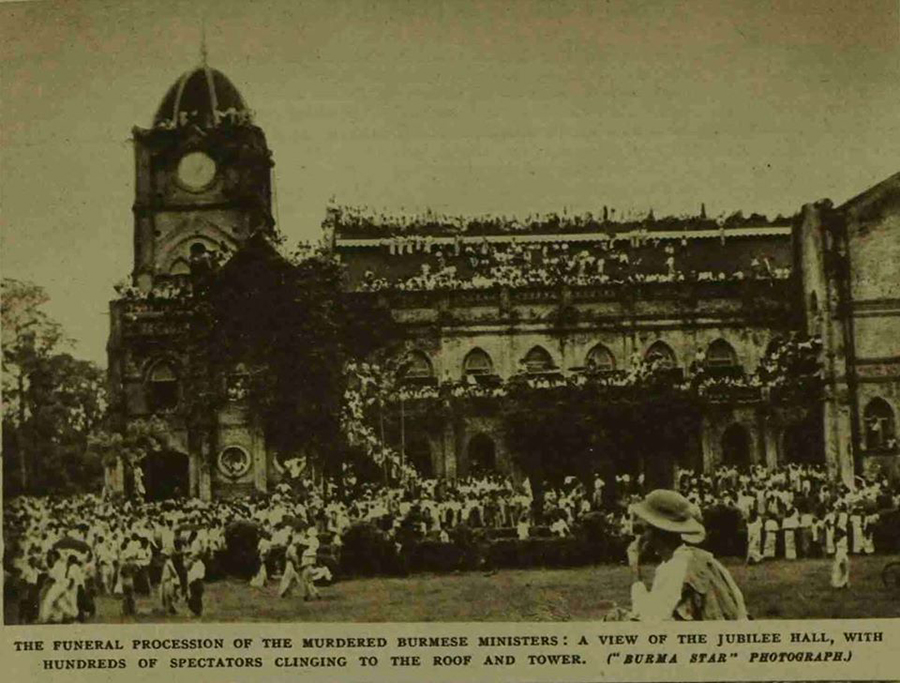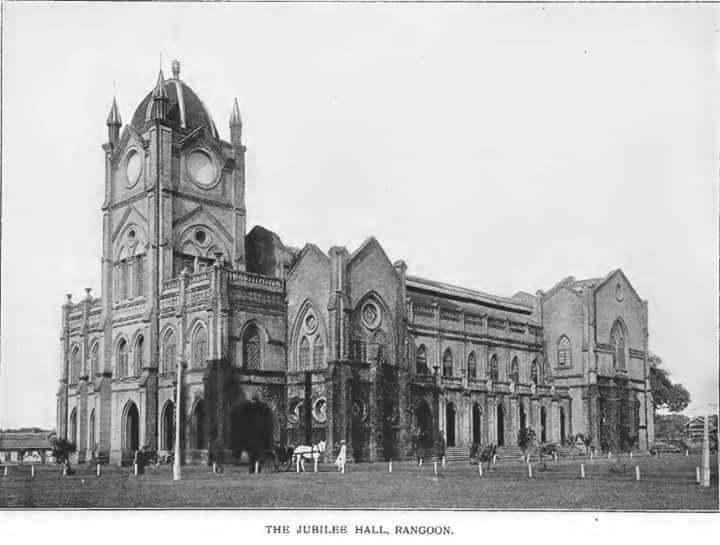The Jubilee Hall was the most popular venue for ceremonial occasions and gala events during the colonial period in Yangon (then known as Rangoon). Located on Shwedagon Pagoda Road in Dagon Township, it was one of the most magnificent buildings in Yangon until it was demolished some 30 years ago.
The structure was built to mark the 60th year of the reign of Queen Victoria (her Diamond Jubilee) in 1897, though construction was not actually complete until December of the following year. The Gothic-style building emerged some distance from downtown and Shwedagon Pagoda after three years of work.

The site was previously occupied by a complex of wooden assembly rooms used by the British administration. The facility was 40 over years old when it was transformed into the Jubilee Hall to mark the 60th anniversary of the queen’s coronation.
The two-story Jubilee Hall was managed by Rangoon municipality. In its early days, it hosted events such as a meeting of British government officials to mark the opening of Yangon Zoo, as well as arts-and-crafts shows, talks, ordination ceremonies, wedding receptions for prominent figures of the town, and charity shows to raise funds to help Britain fight World War I. It served as a gathering place for the powerful, educated and wealthy elite.
Entering the landmark building, visitors encountered a reception area between the two flights of a dual staircase, a spacious hall and balcony upstairs, and a stage on the ground floor—perfect for parties and meetings.
The hall was frequented by the cream of society for some 20 years until World War I. As the war raised the political consciousness of Myanmar’s people, the hall was increasingly used for political purposes, hosting meetings on Myanmar’s secession from British India, a campaign to require foreigners to remove their shoes and socks in religious buildings, and calling for home rule. It was at the Jubilee Hall where the anti-colonialist Buddhist monk U Ottama made his famous “Craddock, Get Out!” speech against Sir Reginald Craddock, the governor of British Burma.
But even as anti-colonialist meetings became more frequent, the hall remained the major venue for Christmas parties, dances, boxing competitions, school fun fairs, Anyeint (a traditional Burmese performance art), cane ball competitions and other social occasions.
The first graduation ceremony of Rangoon University, and Myanmar’s first weightlifting contest and beauty pageant were held at Jubilee Hall, which also saw the establishment of the first all-Myanmar students union.
The hall was visited by many distinguished guests including Nobel prize-winning Bengali poet Rabindranath Tagore, Indian nationalist leader Mahatma Gandhi, and Indian political leader Jawaharlal Nehru. Occasionally, it also served as a venue for banquets hosted by Chinese merchants.

At the time, the Jubilee Hall was one of the town’s main aesthetic landmarks, its visual appeal enhanced by the sweet melodies from Royal Scots military bands, traditional Myanmar bands and Indian and Chinese songs that would often fill the surrounding air.
However, the outbreak of World War II silenced the music and left the hall suddenly deserted. Standing some distance from downtown Yangon, it escaped the bombing raids during the war, but parties and ceremonies were few and far between during Japanese rule, during which Myanmar experienced deep hardship.
During the Japanese period, the government of Dr. Ba Maw changed the name of the hall to Maha Bamar Yone Taw Gyi, which can be translated as Great Bamar Royal Hall, but many people continued to refer to it as the Jubilee Hall.
After the war, in 1946, Sir John Gielgud, one of the greatest actors of the time, performed the title role in a production of Shakespeare’s “Hamlet” at the hall.
The following year, the Anti-Fascist People’s Freedom League led by Myanmar’s independence hero General Aung San drafted the country’s first constitution at the hall. The same year, it became a funeral parlor, hosting the most crowded funeral in Myanmar’s history, with the assassinated Gen. Aung San and his slain cabinet ministers lying in state in the hall for six months.
After Myanmar regained independence in 1948, the Jubilee Hall came under the control of the Culture Ministry, and was no longer used as a venue for events and fairs.
Later, Myanmar’s first national library and national museum were opened inside the Jubilee Hall. The site eventually became a cultural center when an art and music school was opened there. However the national library was moved to the city hall in 1968, and the museum was moved to Pansodan Street.
The hall continued to serve as a cultural center, hosting frequent cultural performances by the Culture Ministry and occasional literary talks and art exhibitions.
A powerful earthquake with its epicenter in Bagan rocked the hall in 1975 just as a cultural performance was being staged there. A few concrete pieces fell from the ceiling, but the hall was otherwise undamaged.
The hall survived World War II but could not withstand the plans of the Burma Socialist Programme Party, which knocked the building down in 1985. It was speculated that the military regime demolished the structure because it viewed it as a legacy of the colonial period.
The site fell into the hands of the military, which opened a military museum at the location on March 24, 1994. Today, the site is the home of an ongoing US$300-million (401-billion-kyat) construction project, a joint venture between Japan Overseas Infrastructure Corporation under Fujita Co., and Yangon Technical and Trading Co. under the Ayeyar Hinthar Group of Companies of Myanmar.
Translated from Burmese by Thet Ko Ko
You may also like these stories:
The Free British Colonial Library in Myanmar that Welcomed Everyone
Myanmar’s First Postwar Political Mass Meeting

















